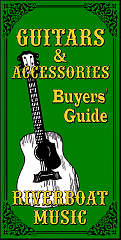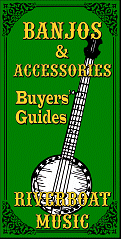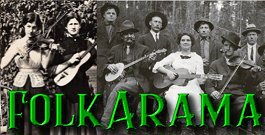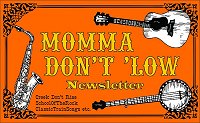
Pick up any old thing and join in!
| Please Read: How to Help Our Site at No Cost to You - Some of our articles contain recommendations for products we like and vendors we personally trust. Some of those vendors may pay us a very small commission if you click on a link and buy their products. This costs you nothing at all and helps offset the costs of what we do. So if we point you to something you decide to buy later, please make certain you come back through our site and click on the link directly. Thanks. |
| This Site is a Cookie-Free Zone - Except for discussion forums that you have to expressly register for, none of our pages use cookies of any kind. Some of the vendors we link to do, but that won't affect you unless you click on a link to their pages. Your continued use of this page indicates that you agree to our policy. For details, click here. |



|


Meet Your Guitar
This is part of the "How To Folk" series of Very Basic Guitar articles. In an effort to "jump start" your enjoyment of Folk music and your ability to join in, no matter what instrument you play, we are providing some very basic notes about guitar chords and how to recognize them, even if you don't play guitar.

 Note: - This part of the Folkarama page, which is dedicated to helping beginners "get into" Folk music and join Folk communities as easily as possible, with simple articles and links to resources that provide hands-on instruction in traditional acoustic instruments.
Note: - This part of the Folkarama page, which is dedicated to helping beginners "get into" Folk music and join Folk communities as easily as possible, with simple articles and links to resources that provide hands-on instruction in traditional acoustic instruments.
Folkarama, in turn, contains many references to more extensive articles and resources in Paul Race's CreekDontRise.com site, as well as other related pages.

Getting to Know Your Guitar
We need to talk about the parts of the guitar somewhere, since we'll be mentioning them again and again.Your guitar may look different than this, but it will include the neck, the strings, the bridge, and the frets. Those are the bits you need to "get to know"
About Guitar Tuning
There are a thousand resources about how to tune your guitar, but that's not what this is about right now.When you start, get someone else to tune your guitar the first time. After that, use a digital tuner if you have one. We'll talk about which strings play which notes later. Believe it or not, that's not the first thing you need to learn.
 Eventually you will need to learn to tune without a digital tuner – for example, you may have to tune down a bit if there’s a “real” piano in the mix.
Eventually you will need to learn to tune without a digital tuner – for example, you may have to tune down a bit if there’s a “real” piano in the mix.
The little chart at the right shows how to tune to a piano or keyboard. But you shouldn't bother paying attention to it right now unless you need to.
But in the meantime, tuning to a digital tuner helps you train your ear to recognize a well-tuned guitar. And playing a guitar that is out of tune, even a little, will "train" your ear to be satisfied with poor tunings. "Close enough for Rock and Roll" is not good enough.
Assume a Position
Assuming you're going to play right-handed:- The indentation on the guitar will probably sit over your right thigh, putting the sound hole a few inches right of your belly button. If you can't play with the guitar balanced this way, use a strap.
- When you reach over the guitar with your right arm, the fingers of your right hand should rest comfortably over the sound hole, or between the sound hole and the bridge.
- Your left hand should be palm-up, with your thumb on the back of the neck and your fingers wrapping comfortably underneath the guitar neck to come down more-or-less straight onto the strings. (Yes, we've all seen the photos of experienced players using a different "hold," but this is the best way to start out.)
Having your hands in comfortable position is critical. If you need to use a strap or to stand or sit on a stool to accomplish this, do so. Otherwise you could develop bad habits that lead to chronic repetitive motion injuries, or, worse yet, sloppy playing.
By the way, if you want to play guitar left-handed, you should meet with an instructor and get suggestions from him or her. There are several ways to play left-handed, and all of them are outside the scope of these articles. In the meantime, I would urge you to learn the basics right-handed. That way you'll always be able to pick up a guitar in a music store or at a party and play something.
Holding the Pick:
Assuming you use the most-common, egg-shaped pick, grasp it between your thumb and forefinger so that only about 1/4" to 1/3" of the pointed end sticks out.Picking the Strings:
When you are holding the guitar, the back of your right hand should be more or less parallel to the face of the guitar. The pick should be about perpendicular to the strings.Initially, it may be easier if the inside of your right forearm (just below the elbow) rests lightly on the face of the guitar to help stabilize your right hand. Eventually you'll be able to play without this accommodation (which, unfortunately, deadens the guitar a bit). But for now this will help you get used to your right hand position.
Practice picking the strings lightly, using only enough of the pick to set the string in motion - perhaps about 1/8". Picking harder or picking with more of the pick will not make the guitar much louder and will be hard on the strings.
When you pick or strum the guitar, most of the action comes from rotating your wrist, rather than windmilling your whole arm like the rockers on TV do. When you go from picking the lowest strings to picking the highest strings, your hand will move up and down an inch or two. But the quickest way to lose flatpicking accuracy - and to put unnecessary scratches on the face of your guitar - is to use your elbow as the primary fulcrum of your movements and "wail" on the poor instrument.
Resources
There are plenty of guitar instruction materials, online, of course. But we are working on a few that will help you learn the most basic, but necessary, information quickly.The current resource we have ready to publish is:
- Three Magic Chords - a three-part series to introduce enough easy guitar chords to get you started on learning scores of 2- and 3-chord songs.
Other resources should follow soon.
Return to the VERY Basic Guitar page.
Conclusion
The first several days of learning on guitar are the hardest. If you can learn the chords in our Three Magic Chords lessons and practice 3-chord songs you like for a while, you'll build up the left-hand strength and callouses (and hopefully the right-hand coordination) you need to keep moving forward.Once again, even if some other instrument is or becomes your core instrument, knowing at least some guitar will benefit you in many ways.
Other resources will be listed as I get to them.
Please contact us with questions or concerns. MOST of our articles come from answering previous reader questions, so we value youro input.
Sister Sites
 Other sites we started to keep this site from getting too big to be useful include:
Other sites we started to keep this site from getting too big to be useful include:
- CreekDontRise.com is a repository of articles about Folk music and the instruments on which it has been traditionally played.
The "Acoustic" page includes a long list of articles including maintenance and playing tips on all sorts of traditional acoustic instruments.
 RiverboatMusic.com is a buyers' guide for acoustic and traditional instrument from a musician's point of view, focusing on the uses, reliability, and practicality of various instruments, and not just the marketing hype about the shape of the fret markers or whatever.
RiverboatMusic.com is a buyers' guide for acoustic and traditional instrument from a musician's point of view, focusing on the uses, reliability, and practicality of various instruments, and not just the marketing hype about the shape of the fret markers or whatever.
For instruments like dulcimers that have mostly small manufacturers or cheap imports, we try to tell you what to look for, irrespective of brand.
 Momma Don't 'Low includes a free e-mail newsletter that discusses all of those topics above and more. We plan to include other features as time permits.
Momma Don't 'Low includes a free e-mail newsletter that discusses all of those topics above and more. We plan to include other features as time permits.
Note - If you wish to sign up for our newsletter and ask a question at the same time, please click on the Momma Don't 'Low newsletter button to learn more and to get a link to our signup form.
 PaulRaceMusic.com is the "landing page" for Paul's own musical endeavors, plus many memoirs and blogs about music and the music business.
PaulRaceMusic.com is the "landing page" for Paul's own musical endeavors, plus many memoirs and blogs about music and the music business.
 ClassicTrainSongs.com describes railroad songs that every train lover should know. Or at least know about.
ClassicTrainSongs.com describes railroad songs that every train lover should know. Or at least know about.
- SchoolOfTheRock.com has articles about Christian music, Christian music careers and performance, Christian living in general, and vintage saxophones, another of Paul's interests. This site has separate newsletters, etc., by the way - there isn't a lot of overlap with the Momma Don't 'Low(tm) newsletters.
For information about other music collections and projects, check the links at the bottom of this page.
 Whatever else you get out of our pages, I hope you come away with some great ideas for "sharing the joy."
Whatever else you get out of our pages, I hope you come away with some great ideas for "sharing the joy."
And please stay in touch!
All material, illustrations, and content of this web site is copyrighted (c) 2001, 2002, 2003, 2004, 2005, 2006,
2007, 2008, 2009, 2010, 2011, 2012, 2013, 2014, 2015, 2016, 2017, 2018, 2019, 2020, 2021, 2022, 2023 by Paul D. Race. All rights reserved.
Creek Dont' RiseTM is a participant in the Amazon Services LLC Associates Program, an affiliate advertising
program designed to provide a means for sites to earn advertising fees by advertising and linking to Amazon.com.
For questions, comments, suggestions, trouble reports, etc. about this page or this site, please contact us.
| Visit related pages and affiliated sites: | |||||
| - Music - | |||||

|
 |
 |

|

|

|

|

|

|

|

|

|

|

|

|

|

|

|
| - Trains and Hobbies - | |||||
 |

|

|  |
 |

|
| - Christmas Memories and Collectibles - | |||||
 |

|
 |

|
 |

|
| - Family Activities and Crafts - | |||||
 |

|

|

|

|

|


